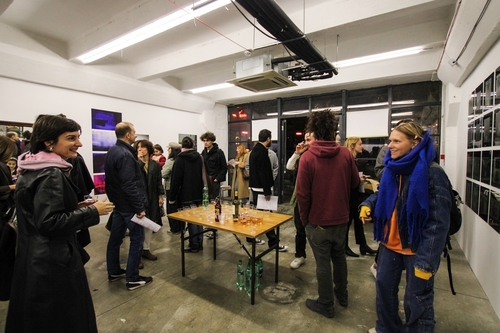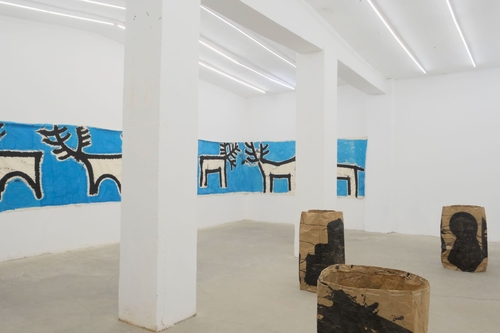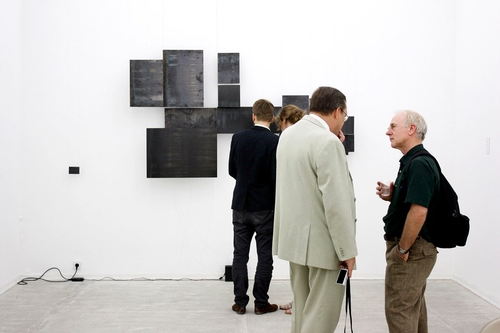Exhibitions
| The Center of Contemporary Art - Tbilisi has been at the forefront of contemporary art since 2010. dedicating itself to promoting creativity, nurturing innovative thinking and supporting emerging artists in the region, it has successfully organized over 300 exhibitions, featuring more than 1,000 works from both Georgian and international artists. The exhibitional platform of CCA not only promotes artistic development but also enriches the cultural landscape, making it an ultimate hub for artistic exploration and innovation. |
|---|

|
As part of The Center of Contemporary Art’s Creative Mediation program, Beat Streuli led a series of workshops and presented the results of the process in the form of an exhibition. Artists: |

17.10.2024 - 07.11.2024
|
There is a Chinese painting style and theory which organises the image in three plains; the foreground, the central plain and the background. The background in these paintings is mostly occupied by mountains, individualised and speaking, depicted as the main carrier of emotion and feelings between the people. In the foreground you sometimes see people, sometimes acting but very often, tiny figures as which they are depicted, gazing at the mountains, their backs turned towards us. In between these different plains are voids, huge empty spaces that are supposed to make up for at least eighty percent of the surface. These white areas sometimes evolve from painted clouds into which they are also dispersed. The voids fill with projections, artifacts of movement, produced by the mind in images it discards as improbable or recognises as possible doublings of forms. They move in themselves, hardly memorable otherwise than in a feeling, a glimpse caught for a moment. Academic as rules of painting tend to be they offer a place for undecidedness and retreat, shifting responsibility to an accurate following. The projections are unruly, though, but hard to grasp.
See more about the artists: |

|
1.06.2024
Ulrich Polster |

11.10.2025 – 11.11.2025
|
This solo exhibition at CCA Tbilisi presents a project by the Taiwanese artist-writer duo Hsu Che-Yu and Chen
See more about the artists: |

|
10.05.2024
Artists: Keti Chiqovani, Elene Kacharava, Gio Sumbadze. |

26.04.2024 - 28.04.2024
Photographs from the Familia ongoing projekt have been taken over a period of 2014-2024 in various countries including Ukraine, Russia, Georgia and France. The project deals with how the war in Ukraine affects the lives of Ukrainian-Russian couples, showing both a tragedy and mass displacement of families, but also love stories and contradictory narratives from a human perspective.
The exhibition brings together works from her several ongoing projects, linked by a personal experience, that explore the themes of borders, conflict and the language we use to communicate with each other. Confronting the increasingly divided and antagonistic world in which we find ourselves today, the exhibition addresses a way to designate movement over or beyond borders, when love conquers all.
| Artist: Oksana Yushko @yushkooksana Curated by: Ulrich Polster @ulrichpolster2 @call_a_friend_project |

19.04.2024

12.04.2024 - 14.04.2024
Personal narratives, testimonies, and artistic expressions come together to explore various aspects of identity and belonging - from the surreal uprooting of ancient trees to the confrontation of a ‘place to be’ and ‘non-places’, from self-discovery and transformation of family values and a concept of home to the challenges of migration and displacement, from the pursuit of utopia to the sense of self and interconnectedness. The exhibition room is a communication space where moving images and artistic conversations invite viewers to reflect on the complexities of human experiences and the search for meaning in the contemporary world.
| Artists: Tina Bara / Lange Weile (2016) Dima Gomberg @dmitrygomberg / On the Road Home (2023) Salome Jashi @salome_o_jashi / Taming The Garden (2021) Garush Melkonyan @garushmelkonyan / The Italian Method (2016) Ulrich Polster @ulrichpolster2 / Fragment II (2004) Curators: Tereza Davtyan @teresa_davtyan Ulrich Polster @ulrichpolster2 Oksana Yushko / Call A Friend project @call_a_friend_project |

03.11.2023 - 01.12.2013
A solo exhibition by the Swiss Artist, Beat Streuli.
In July 2023 the artist went on a road trip from Tbilisi to his mother's birthplace Tashir, formerly Vorontsovka and today in Armenia. In Tbilisi and a number of small towns on the way he captured photo and video footage and presented in the rooms of CCA as a large-scale installation of projections and wallpapered images.
Zones Neutres follows the path of Beat Streuli's ancestors, and (re)searches stories and places of their existence, examining how time and historical shifts have left their traces in the area and on the local community. The past and its events are reimagined and linked to the present.
With the support of the Swiss Arts Council Pro Helvetia.
Beat Streuli
My mother, Rosalie Urfer, was born in 1920 in the Caucasus, the daughter of Swiss cheesemakers. By then, two generations of the family had been living and working in Georgia. On the poster is the wedding photograph of her parents, taken in Tbilisi in 1907. When my mother was just two years old, the family returned to Switzerland.
Recently, I wanted to know more about this story. My main source of information was a book entitled Swiss Cheesemakers in the Tsarist Empire (Gisela Tschudin, Zurich 1990), in which my mother had highlighted her birthplace, Vorontsovka, as well as a few other names and places. In July 2023, I went on a road trip between past and present, from Tbilisi to Tashir in Armenia, formerly Vorontsovka.
Alexandersdorf – Didube
Starting in Tbilisi, we learned that there are two city neighborhoods that in the 19th century were German villages. Although hardly any of the original architecture remains in what was once Neu-Tiflis, some early houses are still standing in Didube. They are in poor condition, and due to rapid urban development, they risk disappearing in a few years.
Alexandersdorf, as the settlement was called, was founded in 1818. My Swiss ancestors arrived 60 years later, but their story is connected to that of many of the Germans who, on the invitation of the Tsars, came to the Russian Empire to practice agriculture.
The Russians wanted to introduce Western agricultural know-how in their vast territory. For the settlers, this represented new opportunities and an escape from sometimes difficult conditions in their home countries. It was emigration in the opposite direction to what is most common today.
Elisabethtal – Asureti
Our first stop after leaving Tbilisi was the former Elisabethtal. Like Alexandersdorf, this German settlement was founded in 1818, but unlike it, today’s Asureti is well renovated with many houses in a cross-cultural mix of traditional German and Georgian architecture. The Evangelical Lutheran church was perfectly restored in 2019 and the bell tower has been reconstructed. A German cemetery still exists, but there were no graves associated with my family, as far as we know. The settlers here lived from cattle breeding, beekeeping and fruit growing. Today, wine is also produced.
Alexandershilf – Trialeti
A one-hour drive westwards is Trialeti, located at the edge of the Lesser Caucasus. It was once called Alexandershilf, a German settlement founded in 1860.
My great-grandfather, Johannes Locher, arrived here from Switzerland in 1882 and eventually found work as a cheesemaker. It was also where he met his future wife, Wilhelmine Rösch, the daughter of a well-established German family in Alexandershilf. They had four children, among them my grandmother, Marie Locher.
My grandfather, Gottfried Urfer, meanwhile, grew up on his family’s farm in the Bernese hills and, in search of a better future, emigrated to the Caucasus as a teenager. He met his compatriot Johannes Locher in Alexandershilf and a few years later married his daughter, Marie. He was 24 and she was 17 at the time. The wedding most likely took place in the church of Alexandershilf, which had been inaugurated in 1906.
From the early days of the Soviet Union, this church served as a cultural center and cinema, a transformation that is still visible today. Most of the original houses built by the German settlers are preserved and inhabited. Progressively, new residents from various Caucasian regions repopulated Alexandershilf. As in all settlements, the last remaining Germans were deported to Kazakhstan in 1941.
Katharinenfeld – Bolnisi
Further southwest, Katharinenfeld, another German village founded in 1818, was renowned for its viticulture. Unlike Elisabethtal and other colonies, Katharinenfeld occupied land previously farmed by Tatars and other locals, which often led to violent conflicts in the following decades. This was also the case in Alexandershilf and for several German and Swiss farms in the surrounding area.
Katharinenfeld was an important social center for local settlers. Those living in farms on the plains of the Lower Kartli region came to town for social, religious, and cultural activities. The Swiss farmers clan - the Ammeters - lived at a distance of 30 kilometers in Karabulagh, and the famous Baron Alexander von Kutzschenbach not much further away.
Both the Baron and the Ammeters played an important role as the first employers of Swiss cheesemakers. My great-grandfather Johannes Locher and prominent Swiss figures like Gottfried Graf started working for them after arriving from Switzerland. My mother’s birthplace, Vorontsovka, was also part of the wider hinterland of Katharinenfeld.
As in other places, the majestic bell tower of the local church was razed by the Soviets and has not been rebuilt yet. The church building was transformed into a sports center, which it remains today. We met the gentleman running it, who is also the author of a book about the German history of Bolnisi.
Bolnisi to Privolnoye
After driving up from Bolnisi to the Armenian border at Guguti, a magnificent, overwhelmingly vast highland opened before us, lined in the distance by bare mountain ranges: the upper Lori region. In the middle of the plain lies Tashir, formerly Vorontsovka.
Our first stop was Privolnoye, a small, originally Russian village in the rolling hills behind Tashir. I had read that one of the Swiss farmers and beekeepers operating in the region, Christian Siegenthaler, owned a cheese factory there around 1900. We could find no trace or knowledge of this, but locals to whom we explained our search showed us one of the dairies currently operating in Privolnoye.
Katnarat
We told our story to an Armenian customs officer when crossing the border from Georgia to Armenia. She mentioned that the Lori region is also called little Switzerland and told us about another village near Tashir called Katnarat.
Our arrival coincided with the centenary celebrations of this farming village, 10 km outside Tashir. The customs officer had seen a television report mentioning that the original founder of the Katnarat stud farm and cattle ranch had been a Swiss named Gottlieb Graf, who is still well remembered in the local community.
The villagers showed us the tombstone of Elisabeth Bösch, born Siegenthaler, who died in 1902. It transpired that the Swiss families Bösch, Siegenthaler and Graf had initially run the farm together. Several cheesemakers from Switzerland had worked for them, and I assume that my grandfather, Gottfried Urfer, was one of them. Later, we were led to the ruins of Gottlieb Graf’s home and an ice cellar at the foot of Mount Garacharch on the banks of the small Kaminka River.
Vorontsovka – Tashir
Today, Tashir is an elongated and lively hub along the road that intersects it. The Siegenthaler family moved there temporarily around 1900 after a dispute with the Grafs and started a cheese factory.
Although there was a school in town, it was too dangerous for the children to walk the long stretch from home to school because wolves still roamed the area. I read in an aunt’s journal that my mother’s older siblings could read and write when they returned to Switzerland because their father had taught them himself.
In Soviet times there was a huge cheese factory in Tashir. It fell into ruins after the earthquake of 1988 and was abandoned at the end of the Soviet Union. We visited these ruins as well as a new factory, Dustr Melania, which until recently still produced Emmentaler, the popular cheese once made by the Swiss in the Caucasus.
Gisgalà – Getavan, Urasar
After spending several years in Vorontsovka, the Siegenthalers moved to a small nearby village called Gisgalà. Now a quiet place called Getavan, it is surrounded by beautiful landscapes and dotted with ubiquitous stork nests. In 1909, they left the region altogether, so it is likely that my grandfather mostly worked for Gottlieb Graf, and then started his own business.
Not far from Getavan, in a village called Urasar, locals pointed out another cheese factory, also in ruins, which had probably been operated by Swiss cheesemakers.
Katnarat
City officials in Tashir had told us about Lena, an old lady living in Katnarat, who was keeping the memory alive of the village’s Swiss founder. We returned to Katnarat and Lena read to us from her notes, with our new acquaintances from Tashir translating, and we looked through a photo album from the 1940s when Katnarat had become a kolkhoz.
At the beginning of the 20th century, Graf’s farm was a huge operation with more than 700 cattle and horses. With World War I and the disintegrating order in the aftermath of the Russian Revolution, those prosperous times came to an end. In February 1918, Turkish and Tatar raiders, some of them the original inhabitants of the land, robbed Graf of everything, including his cattle and horses.
In December of the same year, the short Georgian-Armenian war brought further unrest. It seems that some Swiss continued to try and run the farms in the 1920s, despite expropriation and collectivization.
Zones Neutres
After the Georgian-Armenian conflict, so-called Zones Neutres were declared in the North Lori region. Like the independence of Georgia and Armenia, they were short-lived and ended in 1921 when the Bolsheviks pushed forward with their revolutionary plans. It was in these violent times that my mother was born, in Vorontsovka or on a farm nearby. Certainly, her father had worked with the Siegenthalers and the Grafs and later had his cheese factory. But we have not yet found much further evidence or details about my immediate ancestors, as opposed to what emerged about more influential Swiss figures.
We have seen the landscapes that surrounded and defined the spaces in which my family lived and worked. Spaces to be filled by imagination, similar to the expression Zones Neutres. It made me think of the TV series Westworld and its maze, where traces are found in a wide landscape and then uncertainty returns. However, we do know more about what happened after all of this. My mother and her family, as well as many other Swiss
and Germans, left the Caucasus in 1922, expropriated and fearing persecution. After a long journey, they arrived in the Bernese countryside of Switzerland.Impoverished, it was difficult for them to make a new start in a country that was foreign to them. Things did not go smoothly. My grandfather moved to France, where he found work, but died early. My grandmother, who was born in Alexandershilf and felt more Caucasian-German than Swiss, began to suffer from mental illness, and her children were taken away from her. Growing up separately, all four siblings eventually built good lives despite their difficult early years.
Text translated by Liz Morrison

06.10.2023 - 28.10.2023


|
10.04.2015 - 10.05.2015
On the exhibition „A Word to be Wiped Away A Day“ held at the Center of Contemporary Art Tbilisi visitors were welcomed by a wall that listed words to be wiped away daily. To find the words which will be wiped out, the Zurich based artist group RELAX and a team of the CCA asked all kind of people in Tbilisi to tell them which words they would like to erase from the vocabulary of their language. The same CCA team worked together with Marie-Antoinette Chiarenza and Daniel Hauser from RELAX on the translation of „the wealth manifesto“ from english to the Georgian language. The manifesto was formulated by RELAX for their show „what is wealth?“ at Cornerhouse Manchester in Great Britain in 2010 and has been translated so far in spanish, italian and turkish. Curator: Mariam Natroshvili |

|
27.12.2013-05.01.2014
1st exhibition by 2013-2014 students of The Informal Master Program. Curators: Mako Kapanadze, Ana Jiqia, Tamar Gobronidze. |

|
28.12.2012 - 14.01.2013
1st exhibition by 2012-2013 students of Informal Master Programs. Curator: Mariam Natroshvili |

|
Participants: Irine Jibuti [Surface]; The Fleetgroup; George Maghradze; Guram Tsibakhashvili; Hans Heiner Buhr; Kote Jincharadze; Krzysztof Wegiel; Multimedia Art Group Stigmat [Spice] Curators: Irine Jorjadze [Surface]; |

|
28.05.2011
Exhibition dedicated to the 20th anniversary of Georgia's independence Artist: Voldemars Johansons Curator: Wato Tsereteli
|

|
18.03.2011
Participants: Avtandil Avaliani, Mamia Avaliani, Vakho Bugadze, Zura Gikashvili, Misha Gogritchiani, Kote Jincharadze, Qristine Kkabadze, Irma Lezhava, Konstantin Mindadze, Koka Ramishvili, Misha Shengelia, Murtaz Shvelidze, Kote Sulaberidze, Oleg Timchenko, Koka Tskhvediani. Curator: Wato Tsereteli |

|
21.01.2011
Participants: Dima Dadiani, Qristine Kakabadze, Dato Margiani, Konstantin Mindadze, Giorgi Jorjoliani, Maja Sumbadze. Curator: Wato Tsereteli Concept By: Konstantin Mindadze, Wato Tsereteli. |
The development of an artistic production, the process itself offers to the author surprises, accidents and unexpected moves, but those unique stages are only visible for the artist only. The spectator mostly gets to see final products of the creative work. Sometimes project studies are more interesting than final result itself, because at this stage artist creates his/her very first raw marks, which are often spontaneous, emotional and vital. ON THE WAY is an attempt to create visual, audio, textual and environmental platform, which can allow to the viewer to experience the exceptional production practice. Exhibition will include selected studies, sketches and projects in progress.
The exhibition was made possible by generous support of Art Ex East

|
30.10.2010
Participants: Martinka Bobrikova, Oscar De Carmen, Guido Pierri, Emanuel Svedin, Siri Tolander. Curator: Wato Tsereteli |

|
2.06.2024
Noturno I |
